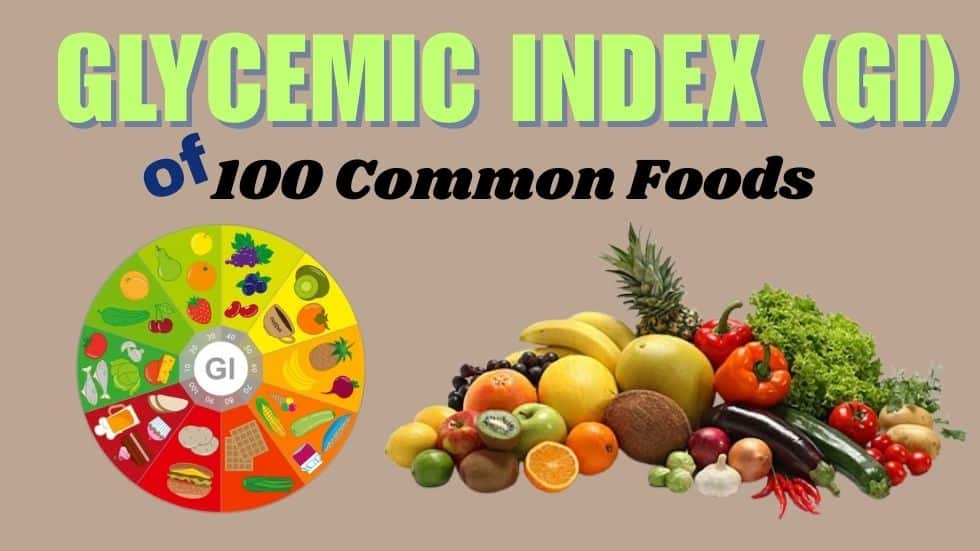Glycemic Index (GI)
Ever wondered why some foods make you feel energized for hours while others leave you hungry again in no time? It all comes down to something called the glycemic index, or GI for short. Think of it as a food’s “sugar impact score” – it tells us how quickly different foods affect our blood sugar levels.
How does it work?
Picture a scale from 0 to 100, where pure glucose gets a perfect 100 (it’s like the speed champion of blood sugar spikes!). Other foods fall into three main groups:
- Foods that take their sweet time (Low GI: 55 or less)
- Middle-of-the-road options (Medium GI: 56-69)
- The quick-hit squad (High GI: 70+)
The Science Behind the Score
You know how some mornings you eat breakfast and feel hungry an hour later, while other meals keep you going until lunch? That’s the GI at work! Foods packed with refined sugars are like sprinters – they cause a quick energy burst followed by an equally quick crash. On the flip side, low-GI foods are more like marathon runners, releasing energy slowly and steadily throughout your day.
More to Explore: ➜ Breaking News: Scientists Reveal Game-Changing Weight Loss Methods!
Why Should You Care?
Here’s where it gets interesting. Getting familiar with the GI can be a game-changer for your health:
For the diabetes warriors: Keeping an eye on GI can help manage blood sugar levels better. It’s like having a roadmap for smarter food choices.
Fighting the battle of the bulge? Low-GI foods are your new best friends. They help you feel fuller longer, so you’re less likely to raid the snack drawer mid-afternoon.
Heart health: Your heart actually loves low-GI foods! They can help boost your “good” cholesterol while keeping the bad stuff in check.
Fun Fact: The same food can have different GI scores depending on how you prepare it. Take pasta, for example – cook it al dente, and it’s actually better for your blood sugar than when it’s cooked until super soft. Who knew being a bit undercooked could be a good thing?
Don’t Miss This: ➜ Say Goodbye to High Blood Pressure with These Natural Wonders!
What Affects a Food’s GI Score?
It’s not just about the food itself – several factors can change the game:
- Cooking style: Different cooking methods can change how quickly your body processes the food
- Ripeness matters: That spotty banana on your counter? It’ll spike your blood sugar more than its greener cousin
- Food combinations: Adding protein or healthy fats to your meal can help slow down the sugar rush
While the GI is a helpful tool, don’t get too caught up in the numbers game. Think of it more as a friendly guide than strict rules. After all, a balanced diet is like a good playlist – it’s all about mixing things up!
Remember, making healthier food choices doesn’t mean you need a science degree. Sometimes, it’s as simple as understanding how different foods affect your body and making small, smart swaps in your daily routine.
Low Glycemic Index (55 or less) – Fruits
| Food Item | GI Value | Serving Size |
|---|---|---|
| Apples | 40 | 120g |
| Apple juice | 39 | 250g |
| Apricots (dried) | 32 | 60g |
| Bananas | 47 | 120g |
| Grapefruit | 25 | 120g |
| Grapes | 43 | 120g |
| Mangoes | 51 | 120g |
| Oranges (raw) | 48 | 120g |
| Pears | 38 | 120g |
| Plums | 53 | 120g |
| Strawberries | 40 | 120g |
| Cherries (fresh) | 22 | 120g |
| Dragon fruit | 48 | 120g |
| Pomegranate | 53 | 120g |
Discover More: ➜ Say Goodbye to Back Pain: Expert-Approved Solutions Revealed!
Low Glycemic Index (55 or less) – Vegetables
| Food Item | GI Value | Serving Size |
|---|---|---|
| Carrots (raw) | 35 | 120g |
| Broccoli | 15 | 120g |
| Green peas | 51 | 150g |
| Sweet corn | 52 | 150g |
| Tomatoes | 15 | 120g |
| Spinach | 15 | 120g |
| Bell peppers | 15 | 120g |
| Eggplant | 20 | 120g |
| Zucchini | 15 | 120g |
| Cauliflower | 15 | 120g |
Recommended for You: ➜ The Ultimate Guide to Conquering Arthritis Naturally!
Low Glycemic Index (55 or less) – Legumes & Pulses
| Food Item | GI Value | Serving Size |
|---|---|---|
| Lentils (cooked) | 32 | 150g |
| Chickpeas (cooked) | 28 | 150g |
| Black beans | 30 | 150g |
| Kidney beans | 29 | 150g |
| Soybeans | 15 | 150g |
| Mung beans | 31 | 150g |
| Split peas | 32 | 150g |
| Navy beans | 31 | 150g |
| Pinto beans | 39 | 150g |
Low Glycemic Index (55 or less) – Grains & Cereals
| Food Item | GI Value | Serving Size |
|---|---|---|
| Quinoa (cooked) | 53 | 150g |
| Barley (cooked) | 28 | 150g |
| Steel-cut oats | 52 | 150g |
| Wild rice | 45 | 150g |
| Bulgur | 48 | 150g |
| Pearl barley | 25 | 150g |
| Buckwheat | 54 | 150g |
Keep Reading: ➜ The Ultimate Guide to Beating Diabetes Naturally!
Medium Glycemic Index (56-69) – Fruits
| Food Item | GI Value | Serving Size |
|---|---|---|
| Apricots (canned) | 64 | 120g |
| Cantaloupe | 65 | 120g |
| Figs (dried) | 61 | 60g |
| Dates | 62 | 60g |
| Kiwifruit | 58 | 120g |
| Peaches (fresh) | 56 | 120g |
| Raisins | 64 | 60g |
| Papaya | 59 | 120g |
| Mango (ripe) | 56 | 120g |
Medium Glycemic Index (56-69) – Starches & Grains
| Food Item | GI Value | Serving Size |
|---|---|---|
| Sweet potato (boiled) | 61 | 150g |
| Couscous | 65 | 150g |
| Brown rice | 68 | 150g |
| Basmati rice | 58 | 150g |
| Whole wheat bread | 69 | 30g |
| Pita bread | 57 | 30g |
| Popcorn | 65 | 30g |
| Muesli | 57 | 30g |
| Rye bread | 65 | 30g |
Popular Reads: ➜ Unlock Optimal Thyroid Health with These Amazing Natural Solutions!
Medium Glycemic Index (56-69) – Prepared Foods
| Food Item | GI Value | Serving Size |
|---|---|---|
| Macaroni and cheese | 64 | 180g |
| Pizza (cheese) | 60 | 100g |
| Sushi rice | 67 | 150g |
| Rice noodles | 61 | 150g |
| Udon noodles | 62 | 150g |
| Rice crackers | 62 | 30g |
High Glycemic Index (70 and above) – Fruits & Vegetables
| Food Item | GI Value | Serving Size |
|---|---|---|
| Watermelon | 80 | 120g |
| Pumpkin | 75 | 150g |
| Parsnips | 97 | 150g |
| Rutabaga | 72 | 150g |
Must-Read Article: ➜ The Ultimate Guide to Healing Depression Naturally!
High Glycemic Index (70 and above) – Starches & Grains
| Food Item | GI Value | Serving Size |
|---|---|---|
| Jasmine rice | 89 | 150g |
| White rice | 73 | 150g |
| Glutinous rice | 86 | 150g |
| Potato (instant mashed) | 88 | 150g |
| Potato (mashed) | 83 | 150g |
| Potato (microwaved) | 93 | 150g |
| White bread | 75 | 30g |
| Bagel (white) | 72 | 70g |
| French baguette | 95 | 30g |
High Glycemic Index (70 and above) – Breakfast Cereals
| Food Item | GI Value | Serving Size |
|---|---|---|
| Cornflakes | 81 | 30g |
| Rice Krispies | 82 | 30g |
| Wheat flakes | 77 | 30g |
| Puffed wheat | 80 | 30g |
| Bran flakes | 74 | 30g |
| Instant oatmeal | 79 | 250g |
High Glycemic Index (70 and above) – Snacks & Sweets
| Food Item | GI Value | Serving Size |
|---|---|---|
| French fries | 75 | 150g |
| Pretzels | 83 | 30g |
| Rice cakes | 82 | 30g |
| Doughnuts | 76 | 75g |
| Jelly beans | 80 | 30g |
| Glucose tablets | 100 | 10g |
| Sports drinks | 78 | 250ml |
| Waffles | 76 | 75g |
| Crackers (plain) | 74 | 30g |
High Glycemic Index (70 and above) – Traditional Foods
| Food Item | GI Value | Serving Size |
|---|---|---|
| Taro (cooked) | 86 | 150g |
| Tapioca pearls | 85 | 150g |
| Glutinous rice balls | 92 | 150g |
| Sago pudding | 87 | 150g |
| Cassava (boiled) | 94 | 150g |
Note: Glycemic Index values can vary based on factors such as ripeness, cooking method, and processing. These values are approximate and may vary slightly from other sources. Serving sizes are provided as general guidelines.


